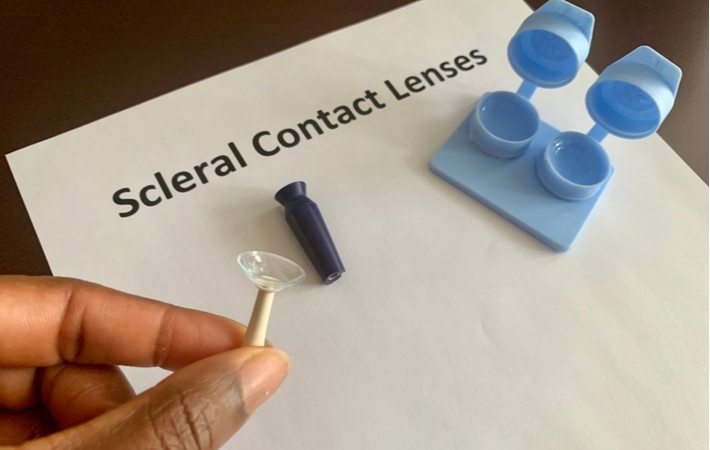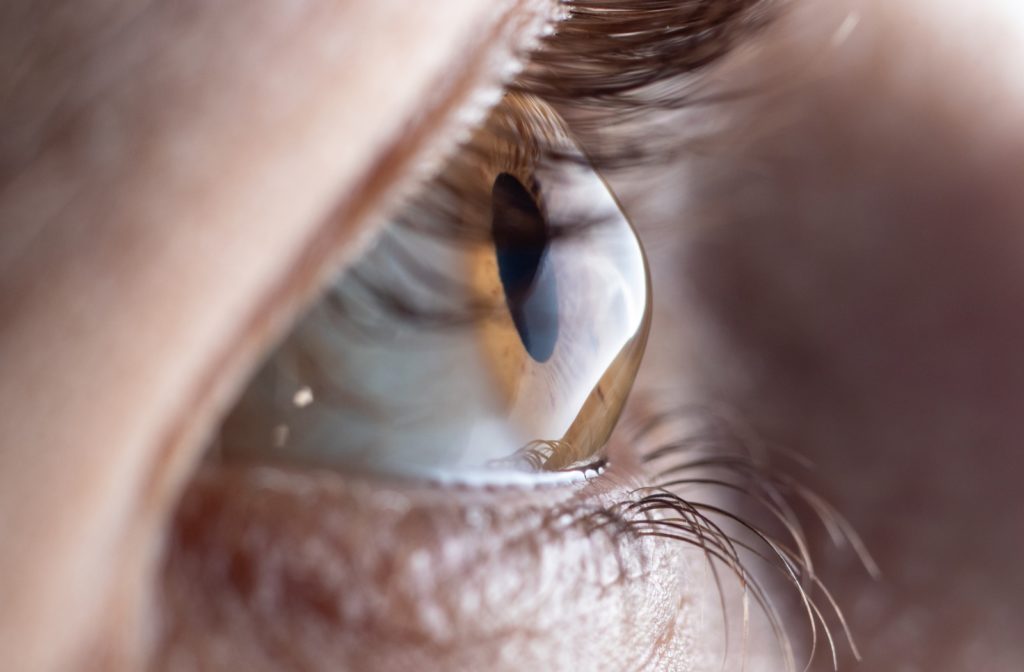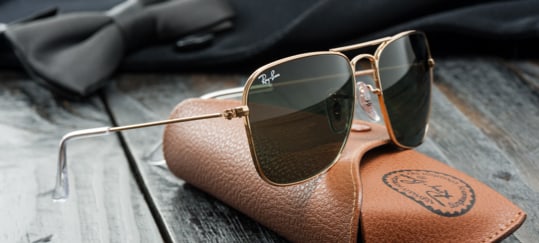Some eye conditions make finding contacts feel impossible. Keratoconus and other eye conditions can affect the shape of your cornea, making traditional contacts a poor fit—literally and figuratively.
Thankfully, there are specialty contacts designed for hard-to-fit eyes, including the larger, more rigid scleral contact lens. These lenses can offer clear vision with many of the benefits of a traditional contact lens.
Read on to learn how keratoconus and corneal shape affect eyesight and how scleral contacts work to correct your vision.
Keratoconus & Irregular Corneas
The cornea is the clear, curved outer layer at the front of the eye. For clear vision, light has to pass through the cornea into the pupil to land on the retina. The retina sends electrical impulses down the optic nerve to the brain, where an image of what we’re viewing is formed.
Irregular corneas can interfere with your vision. Since the light bends through your cornea to enter your eye, any distortions in the cornea can lead to vision problems when the light can’t reach the correct area of the inner eye. Well-known corneal irregularities include astigmatism and keratoconus.
Keratoconus is a condition marked by a thin, bulging cornea that becomes cone-shaped. Keratoconus can result in:
- Distorted vision
- Blurred vision
- Glare
- Sensitivity to light
- Itchy eyes
What Causes Irregular Corneas & Keratoconus?
The cause of keratoconus isn’t entirely understood by medical professionals yet. Keratoconus often appears between the ages of 15–25 and has a tendency to occur in association with:
- Allergies
- Excessive eye rubbing
- Family history (1 in 10 people with keratoconus has a parent with keratoconus)
- Connective tissue disorders
Irregular corneas can be caused by certain eye diseases or disorders. The causes vary, but they can all affect your vision.
What are Scleral Lenses?
Scleral lenses are a type of contact lens large enough to cover the entire cornea and sit on the sclera (the white of the eye). They’re a type of rigid gas-permeable contact lens—meaning they hold their shape and allow an adequate supply of oxygen to reach the eye’s surface.
Their large size and rigidity allow them to act as a replacement cornea. Light refraction errors are corrected since the lenses remain smoothly curved on the eye during wear, allowing for clear vision.
Scleral lenses also have a fluid reservoir that keeps the space between the lens and the cornea moist and comfortable. This is why scleral lenses may be recommended for people who suffer from dry eye disease.

Types Of Scleral Contact Lenses
Scleral lenses are categorized based mainly on size. The 3 common categories of scleral lenses are:
- Corneal or Semi-Scleral Lenses: measuring 12.9mm–14.9mm, these lenses rest on both the cornea and the sclera. For this reason, they have less of an adjustment period than other scleral lenses.
- Mini-Scleral Lenses: measuring 15mm–18 mm, mini-scleral lenses rest entirely on the sclera but cover less eye area than full scleral lenses.
- Full Scleral Lenses: measuring from 18.1mm–24.0mm and above, full scleral lenses rest entirely on the sclera, vaulting completely over the cornea.
EyePrintPRO Lenses
EyePrintPRO lenses are highly customizable scleral lenses designed with 3D printing to create a lens that is perfectly suited to the contours of your eye, which are as unique as your fingerprints. Eye Rx’s own Dr. Teller is currently the only certified EyePrint practitioner in the metropolitan DC area.
A Note Regarding Special Effects Scleral Lenses
Special effects scleral lenses, also called costume contacts, offer eye-altering looks but aren’t used for vision correction. These lenses aren’t true scleral lenses at all; they’re soft lenses designed to cover most of the sclera to make the eye appear as if it doesn’t have a pupil or iris.
Benefits of Scleral Lenses for Keratoconus Patients
Improved Vision
Because scleral lenses are rigid, they hold their shape instead of contouring to the eye. This means the smooth contact lens effectively replaces the cone-shaped natural cornea while the lenses are worn. The refractive errors caused by the misshapen cornea are corrected, which alleviates blurred or distorted vision.
Better Comfort
People with keratoconus, whose corneas are thinner, will appreciate the way scleral lenses vault over the cornea. Since they sit on the less sensitive sclera, they’re a more comfortable choice than traditional contacts.
In addition, the comfort of scleral lenses is boosted by the amount of oxygen allowed through the contact’s gas-permeable material. Between this and the fluid reservoir that keeps the eye bathed in moisture, a more comfortable contact-wearing experience can be had.
Durability
Since scleral contacts are designed to fit the exact contours of your eye, they often have a higher upfront cost. The flip side of this, though, is that their rigidity means they are more durable and can last over longer periods of time.
Scleral Contact Lens Fitting, Insertion, & Wear
Scleral lens fitting is a longer process than fitting soft lenses. Scleral lenses need to be designed and crafted for a custom fit to your eyes. This may lead to multiple visits to ensure the lenses hug your eye near-perfectly.
Inserting scleral contacts may take some time to get used to. Because they are so large, the lens must be overfilled with a solution designed to keep the eye comfortable and moist while you’re wearing them. Overfilling the lens with solution helps prevent air bubbles that may interfere with your vision.
Like most hard lenses, scleral lenses have an adjustment period and will likely take some time to get used to wearing, as well.
Who’s a Good Candidate for Scleral Lenses?
Scleral lenses offer vision correction for plenty of different eye issues and conditions. They may be a valuable option for people with:
- Irregular corneas
- Keratoconus
- Dry eye
- Corneal transplant patients
- Sjogren’s syndrome
- Graft-versus-host disease (GVHD)
- Stevens-Johnson syndrome
Scleral lenses are sometimes used as a bandage to cover the surface of the eye after surgery.
An optometrist with experience fitting specialty lenses may be able to find a scleral lens that suits your eyes and can comfortably correct your vision.
Contact Us for Contact Options
If you have keratoconus or another corneal irregularity, contacts may still be in the cards for you. Book an appointment for a contact lens eye exam with an optometrist experienced in working with hard-to-fit eyes. They may help you find a scleral contact lens that accommodates your unique eyes, corrects your vision, and keeps you comfortable while doing it.



















